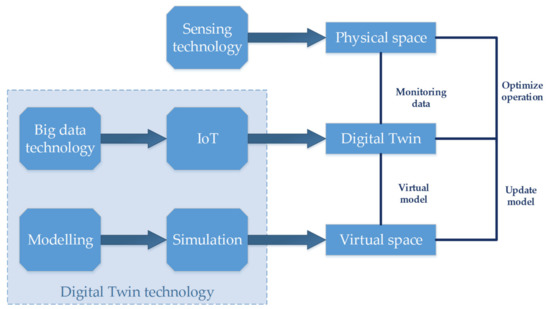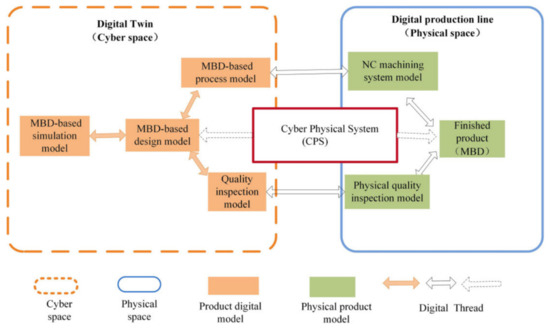Your browser does not fully support modern features. Please upgrade for a smoother experience.
Please note this is an old version of this entry, which may differ significantly from the current revision.
Subjects:
Others
Turbomachinery from a life cycle perspective involves sustainability-oriented development activities such as design, production, and operation. Digital Twin is a technology with great potential for improving turbomachinery, which has a high volume of investment and a long lifespan.
- Sustainability;
- Digital Twin Technology;
- Turbomachinery
1. Introduction
To realize a DT system for turbomachinery, various key technical support [79], such as sensor technology, modelling, and big data technology are needed, as shown in Figure 1.

Figure 1. Key technologies and the relationships of digital twin.
2. Modelling and Simulation
Most of the current modelling and simulation methods are used to develop mature models in specific fields and then use integration and data fusion methods to fuse independent models from different fields into a comprehensive system-level model. However, this fusion method is not deep enough and lacks a reasonable explanation, limiting the usefulness of deep fusion of models from different fields. The difficulty of multi-domain fusion modelling is that the fusion of multiple characteristics will lead to a large degree of freedom of the system equation. The data collected by sensors needs to be highly consistent with the actual system data to ensure the dynamic updating of the model based on high-precision sensor measurement, which requires more advanced research in simulation for DT [80].
DT has been developed from the initial two-dimensional design to three-dimensional modelling and from three-dimensional wireframe modelling to three-dimensional solid modelling and feature modelling. Generally, the 3D model of a product includes geometric information and assembly relationships and manufacturing information such as product manufacturing information, PMI (manufacturing information, including dimensions, tolerances, geometric tolerances, roughness, and material specifications) and other manufacturing information to realize MBD. A fusion of physical space and digital space model is shown in Figure 6.

Figure 6. The fusion of physical space and digital space model [41].
Lightweight 3D models with geometric information can only be extracted from the complete 3D feature models with process features to support 3D product models’ quick browsing. Based on 3D modelling and display technology, VR technology has achieved rapid development. VR is widely used in the virtual experience of complex objects such as automobiles, airplanes, factories, including the immersive virtual reality system cave, 3D rendering technology for product display and marketing, and driving simulation technology. In recent years, AR technology has been developed. AR can integrate physical models and digital models in a visual environment to realize sensor data visualization. Thus, AR can carry out 3D visualization of product operation, assembly and disassembly, and maintenance processes to realize the application of product operation training and maintenance.
Virtual simulation technology has developed from the initial finite element analysis to the simulation of convection field, thermal field, electromagnetic field, and other physical fields such as multi-domain physical modelling. One of the objects of the simulation is physical phenomena, such as vibration, collision, noise and explosion. And the system of the whole product simulation as well as the simulation of various processing technologies such as injection molding, casting, welding and bending, can help the product achieve multidisciplinary simulation and optimization of the overall performance. There are also human factors, equipment, and simulation. If the simulation object is distinguished, the virtual simulation technology can be divided into product performance simulation, manufacturing process simulation, and digital factory simulation [81]. In the design and experiment phase of turbomachinery, the application of the modelling and simulation technologies will help accelerate the construction of complete DT model of turbomachinery.
In the process of digital design technology, virtual simulation technology development and integrated application, digital mock-up (DMU) [82], digital prototyping [83], virtual prototype [84], and functional virtual are used to produce a prototype. Other technologies are mainly used to realize the motion simulation, assembly simulation, and performance simulation of complex products. Through the virtual test of the digital prototype, physical prototypes and physical tests can be reduced, as well as the cost of product development and trial production. Thus, related research and development efficiency can be improved.
2. Sensors and Industrial Internet of Things
With the development of sensor technology and wireless communication technology, the application of the IoT has become increasingly widespread since the 21st century [61]. The Industrial Internet of Things (IIoT) has also been widely used by industry to support the monitoring and maintenance of high value equipment. The data type and acquisition frequency of IIoT are much higher than typical IoT applications. The mathematical model and analysis method of applications are more complicated than in typical IoT applications.
The reliability of turbomachinery DT simulation is highly dependent on the data collected from the actual running device [64]; therefore, a large amount of data is collected by sensors, and software components are also an essential part of it [85]. There are few status parameters monitored in turbomachinery operation with limited measurement positions, such as flow, speed, pressure, and heat flux density. Therefore, more online monitoring technologies should be introduced to collect the status parameters of systems such as wind farms [86], crucial parts of devices such as steam turbines at high frequency, stress distribution, deformation, air velocity, temperature [87], and crack formation.
The combination of the two technologies can be applied to the real-time reporting of wind turbine damage. Based on this, some studies are developing acoustic sensors to monitor the health of wind turbines. The sensor uses the IoT to report in real time, which can improve the efficiency of blade monitoring.
3. Big-Data and AI Technologies
DT itself has a vast database for integrity maintenance and data processing. DT needs this database to maintain geometric integrity, make model discretization, and maintain them during the lifetime of turbomachinery. Simultaneously, the discretized model will be automatically updated with the turbomachinery damage and repair data [88]. Additionally, the generated data from the design, test, or physical operation of the device is also vast. These data must have fast and accurate traceability [89], allowing a user-friendly way to present forecast information to users, support designers or decision-makers to judge [90].
Tao et al. [74] reviewed the concept and application of big data and DT in different phases, including design, production, manufacturing and predictive maintenance. The similarities and differences between big data and DT are compared from the perspective of general data. Because of the complementarity of big data and DT, smart manufacturing can be promoted if the two are integrated.
The monitoring of turbomachinery needs a huge amount of data. Taking the operation monitoring of a steam turbine as an example, the data required to realize the DT of a steam turbine includes the temperature, pressure, and vibration parameters of the cylinder and blades at all stages, which involves big data technology, especially data transmission and data storage. AI technology is also crucial to the construction of a DT model in the operation and maintenance phase of turbomachinery. Continuously training the model through the obtained data, the DT of turbomachinery can independently help technicians get the state of the turbomachinery quickly, and then judge the time and method of maintenance.
This entry is adapted from the peer-reviewed paper 10.3390/su13052495
This entry is offline, you can click here to edit this entry!
